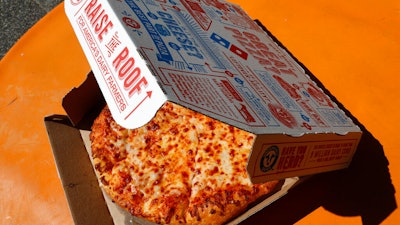
ANN ARBOR, Mich. (AP) — After a pandemic-fueled boom, U.S. pizza sales appear to be headed back to earth.
Domino’s and Papa John’s pizza chains both said Thursday that their same-store sales lost steam in the fourth quarter compared to the huge increases they saw earlier in 2020. Same-store sales are expected to continue seeing percentage declines well into this year.
Pizza delivery remains popular, but diners’ choices are expanding, with more restaurants now offering delivery. In a survey of 3,500 U.S. restaurant operators last fall, the National Restaurant Association found that 27% had added delivery from a third party like DoorDash, while 17% had added in-house delivery. Pizza could also be pressured as the pandemic eases and dining rooms reopen.
“We aren’t sure exactly what the new normal will look like," Domino's CEO Ritch Allison said Thursday during a conference call with analysts.
Louisville, Kentucky-based Papa John’s said its North American same-store sales __ or sales at stores open at least a year __ rose 13.5% in the fourth quarter after skyrocketing more than 20% in both the second and third quarters.
For all of 2020, Papa John's same-store sales jumped 17.6% in North America. But they're only expected to be up 2% this year, according to analysts surveyed by FactSet.
Ann Arbor-based Domino’s said its same-store sales were up 11% in the October-December period. That was short of Wall Street’s forecasts, and below the 17.5% growth the company saw in the third quarter and the 16% growth it saw in the second quarter.
For the full year, Domino's U.S. same-store sales were up 11.5%, well ahead of the 3.2% growth they saw in 2019. But this year, analysts expect they will rise just 1% as sales tumble from their pandemic highs.
Domino's shares dropped 8% to $334.32 in midday trading Thursday. Papa John's shares fell 16% to $86.10.
Allison said the lack of federal stimulus checks impacted demand in the fourth quarter, and the resurgent virus hurt carryout orders. But he also acknowledged that many independent restaurants, which weren’t emphasizing delivery before the pandemic, are now stronger competitors.
“They jumped with both feet into delivery to stay alive,” Allison said in a conference call with investors.
Pizza delivery is also facing a challenge from big chains. McDonald's says its U.S. delivery demand doubled in 2020. Taco Bell also saw higher delivery sales last year.
Uber Eats, one of the largest third-party delivery brands in the U.S., said its active restaurant partners grew by 75% in the fourth quarter compared to the same period a year ago.
Pizza companies aren't the only brands facing slowdowns from pandemic highs. Electronics chain Best Buy said Thursday it laid off 5,000 workers full-time workers this month as it anticipates cooling consumer demand.
Allison said Domino's will focus on growing carryout orders this year. They had been strong before the pandemic but slowed during lockdowns.
Domino's, which uses its own drivers, also hopes to beat third parties like DoorDash by charging less for delivery and opening more outlets, so orders come to customers more quickly. With the economy still rattled, customers are looking for value, Allison said.
“When you think about what it costs to have food delivered to feed a family of four, we really like our positioning in that space,” he said.






















